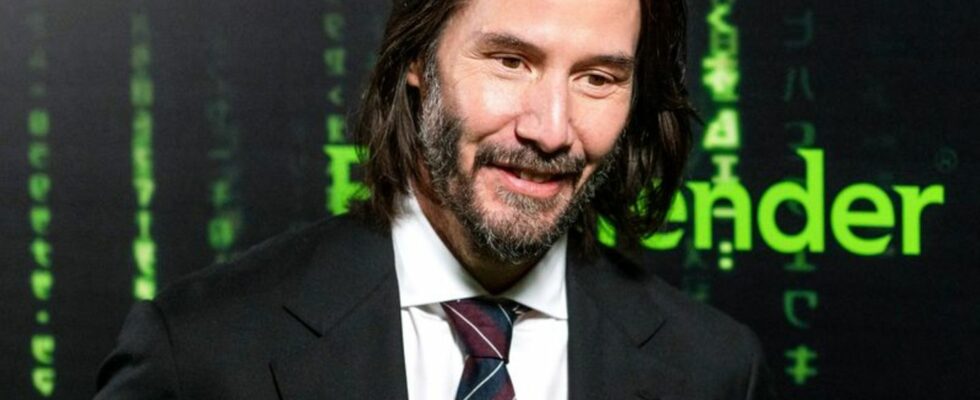Movie
25 years of “The Matrix”: Science fiction then, soon reality?
Keanu Reeves played the hacker Neo in the box office hit “The Matrix”. Photo
© Noah Berger/AP/dpa
25 years ago, the science fiction hit “The Matrix” revolutionized cinema. In times of deepfakes, virtual reality and artificial intelligence, the style-defining thriller is more relevant than it was then.
The rapid advances in artificial intelligence can make you feel uneasy. Much of what is possible today was considered science fiction until recently. The dystopian thriller “The Matrix, which was released in German cinemas on June 17, 1999, is about the dependency between humans and machines. The Wachowskis’ visually style-defining film created a cultural phenomenon and, thanks to its visionary story, is even more relevant 25 years later than it was in the year of its release.
Artificial intelligence takes control
In “The Matrix,” the hacker Neo (Keanu Reeves) discovers that the world he lives in is a simulation created by machines. In fact, he is around 200 years in the future. After a war between humans and artificial intelligence (AI), the earth is devastated. The AI has developed consciousness and taken control. People are bred and kept as unsuspecting slaves. Energy is extracted from their body heat. A computer program – the Matrix – suggests to human brains a normal life in 1999.
Anyone who discovers the truth is hunted by agents (including Hugo Weaving) in virtual reality. This is a computer algorithm that protects the Matrix. Some people have nevertheless managed to escape their slavery. They live in cities beneath the earth’s surface. A group of rebels led by Morpheus (Laurence Fishburn) and Trinity (Carrie-Anne Moss) believe that they have found in Neo the chosen one who can free humanity and destroy artificial intelligence.
“Matrix” serves human fears
Science fiction author Philip K. Dick, whose dystopian novel “Do Androids Dream of Electric Sheep?” was made into a film called “Blade Runner,” had already expressed the theory in 1977 that we humans live in a reality generated by a computer. Dick is considered a great role model for the directors Lana and Lilly Wachowski (then Larry and Andy Wachowski).
When the film premiered, the Internet was still relatively new and cell phones were simple. Artificial intelligence was still in development. But with the new technological developments came fears and worries about where the technology might lead. Like “Terminator” and “Terminator 2: Judgment Day,” “The Matrix” played on these fears. Given the rapid technological advances since then and the current use of AI bots like ChatGPT in everyday life, the idea no longer seems far-fetched.
Groundbreaking visual effects
The action scenes inspired by martial arts films are legendary. The Oscar-winning visual effects set new standards. The so-called bullet time effect, in which the camera appears to move around the fighting protagonists in slow motion, was groundbreaking and style-defining. For this, over 100 photo and film cameras were set up around a scene and then triggered at different times. In the years that followed, many Hollywood films copied the revolutionary effect.
The look of “The Matrix” is dark. In keeping with the green code of the Matrix that flickers across the screens in the film, a dark green filter is usually placed over the image, which is sometimes almost monochrome. The dark world has a dystopian cyberpunk design. The iconic style of “The Matrix” continues to inspire many imitators to this day.
Costume designer Kym Barrett created an ultra-cool, iconic look for the characters with elegant black leather coats and dark sunglasses that had a lasting impact on the fashion world. The fashion magazine “Vogue” stated on the 25th anniversary: ”Even today, designers are still sending leather coats down the catwalk that could appear in any of the “Matrix” films.”
Influence far beyond the cinema
The film’s influence extends far beyond cinema and pop culture. In a key scene, Morpheus tells Neo that he is trapped in a simulation of 1999. Morpheus offers him two pills. “Take the blue pill: the story ends, you wake up in your bed and believe whatever you want to believe. Take the red pill: you stay here in Wonderland and I will show you how deep the rabbit hole goes.” Today, the term “red pill” is a metaphor for recognizing uncomfortable truths in common parlance and in internet memes.
The idea of the matrix was and is also the subject of discussions in various scientific fields, in technology as well as in philosophy and psychology.
“The Matrix” won four Oscars – Best Editing, Best Sound Editing, Best Sound and Best Visual Effects – and is considered one of the most important blockbusters of the past decades, 25 years after its theatrical release.
The film was also a huge commercial success. With a budget of 63 million US dollars, it brought in more than 463 million US dollars at the box office. Three sequels followed: “The Matrix Reloaded”, “The Matrix Revolutions” (both 2003) and most recently “The Matrix Resurrections” (2021). So far, the first part remains unmatched. A fifth film is in the planning stages.

